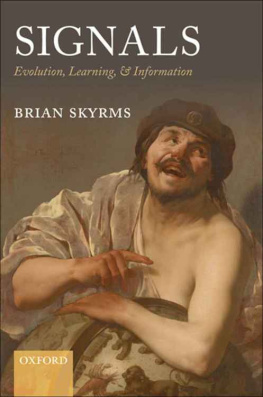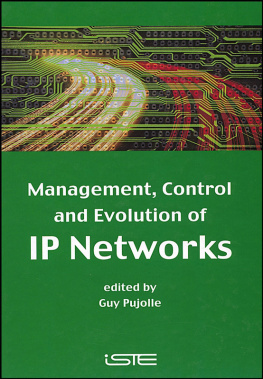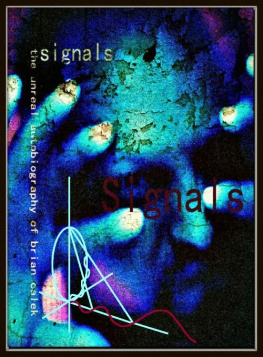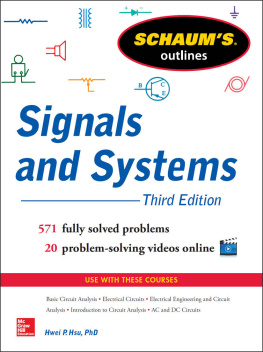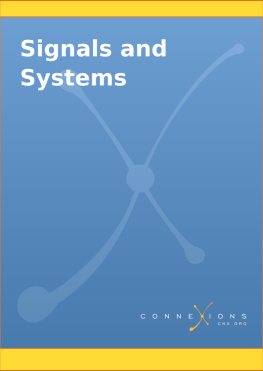Signals
Signals
Evolution, Learning, & Information
Brian Skyrms


Great Clarendon Street, Oxford OX2 6DP
Oxford University Press is a department of the University of Oxford.
It furthers the Universitys objective of excellence in research, scholarship,
and education by publishing worldwide in
Oxford New York
Auckland Cape Town Dar es Salaam Hong Kong Karachi
Kuala Lumpur Madrid Melbourne Mexico City Nairobi
New Delhi Shanghai Taipei Toronto
With offices in
Argentina Austria Brazil Chile Czech Republic France Greece
Guatemala Hungary Italy Japan Poland Portugal Singapore
South Korea Switzerland Thailand Turkey Ukraine Vietnam
Oxford is a registered trade mark of Oxford University Press
in the UK and in certain other countries
Published in the United States
by Oxford University Press Inc., New York
Brian Skyrms 2010
The moral rights of the author have been asserted
Database right Oxford University Press (maker)
First published 2010
All rights reserved. No part of this publication may be reproduced,
stored in a retrieval system, or transmitted, in any form or by any means,
without the prior permission in writing of Oxford University Press,
or as expressly permitted by law, or under terms agreed with the appropriate
reprographics rights organization. Enquiries concerning reproduction
outside the scope of the above should be sent to the Rights Department,
Oxford University Press, at the address above
You must not circulate this book in any other binding or cover
and you must impose the same condition on any acquirer
British Library Cataloguing in Publication Data
Data available
Library of Congress Cataloging in Publication Data
Data available
Typeset by SPI Publisher Services, Pondicherry, India
Printed in Great Britain
on acid-free paper by
Clays Ltd., St Ives plc
ISBN 9780199580828 (hbk.)
ISBN 9780199582945 (pbk.)
1 3 5 7 9 10 8 6 4 2
For Pauline, Michael, and Gabriel
Acknowledgments
This book grew out of my 2006 Presidential address to the Philosophy of Science Association, and the research was partially supported by air force grant FA9550-08-1-0389. Many friends and colleagues contributed to the results presented here. Fundamental analyses of evolutionary dynamics applied to signaling are due to Josef Hofbauer and Simon Huttegger. The basic result for learning dynamics is due to Raffaele Argiento, Robin Pemantle, and Stanislav Volkov. Jeffrey Barrett invented a model in which individuals simultaneously invent categories and code. Kevin Zollman, Rory Smead, and Elliott Wagner provided important results about learning and networks. Jason McKenzie Alexander suggested an interesting version of forgetting to augment learning dynamics. Carl Bergstrom, Michael Lachmann, and Matina Donaldson analyze the equilibrium structure of situations in which there are too few signals. Sven Lauer saw clearly the relation between my version of informational content and the standard philosophers notion of a proposition. Simon Huttegger showed how inductive reasoners can learn to form an information ring. Sandy Zabell introduced me to Hoppes urn, which is the key to a model of inventing new signals.
I owe a lot to feedback that I received from participants in seminars at Stanford and the University of California, Irvine. Duncan Luce read the entire manuscript and provided valuable comments. I would also like to thank Peter Godfrey-Smith, Fred Dretske, Patrick Grim, Louis Narens, Natalia Komarova, Kimberly Jameson, Don Saari, Ken Binmore, Ed Hopkins, Larry Samuelson Simon Levin, Steve Frank, and Patrick Suppes for discussions.
Contents
Introduction
The word is the shadow of the deed.
Democritus
In a famous essay on meaning, H. Paul Grice distinguished between natural and non-natural meaning. Natural meaning depends on associations arising from natural processes. I say that all meaning is natural meaning. This is in the tradition of Democritus, Aristotle, Adam Smith, and David Hume, Darwin, Bertrand Russell, and Ludwig Wittgenstein, David Lewis, and Ruth Millikan. It is opposed to Platonism, Cartesianism, and various stripes of geistphilosophy.
Can the meaning of words arise spontaneously, by chance? We begin by attacking the question (at a high level of abstraction) with a combination of modern tools. The first is the theory of signaling games, in whose use we follow the philosopher David Lewis. The second is the mathematical theory of information, where we replace rather ill-defined questions about the meaning of words with clearer questions about the information carried by signals. This uses ideas deriving ultimately from the theory of Claude Shannon, but elaborated by Solomon Kullback in such a way as to provide a natural definition of the quantity of information in a signal. One of the original contributions of this book is a natural definition of the informational content in a signal that generalizes philosophers notion of a proposition as a set of possible worlds. The third consists in the Darwinian idea of evolution by differential reproduction and natural variation. In particular, we use models of replicator dynamics. The fourth consists of theories of trial and error learning. The evolutionary question is re-posed as a learning question. Can signals spontaneously acquire information through naive learning in repeated interaction? The story, even at this simplified abstract level, is much richer than you might expect. At a more concrete level, there is a vast and growing scientific literature on signaling in and between cells, neurology, animal signaling, and human signaling, that we cannot hope to address here. An account of the biochemistry of signaling in one bacterium Myxococcus xanthus, if it were fully known, would take a book of its ownand I would not be the person to write it. I will stick to the abstract, game-theoretic level. At that level of analysis there is one basic point that is clear: Democritus was right.
Is this the end of our story? No, it is the beginning. Signaling systems grow. That means that signaling games themselves evolve. They are not fixed, closed interaction structures but rather open structures capable of change. We need to study mechanisms that can account for such change. There are two stages of this process that are addressed in this book. One is the invention of new signals. The invention of the original signals needed to get signaling off the ground is a case in point, but there is also the case of invention to get out of information bottlenecks. This book introduces a new accounta new mathematical modelof learning with invention. Invention completely alters the dynamics of learning in signaling situations. The second stage consists in the juxtaposition of simple signals to produce complex signals. Complex signals are a great advance in the evolution of signaling systems. Humans are, of course, very good at this. But, contrary to some claims, neither syntax nor complex signals are the exclusive preserve of humans. It is best then, to think of these not as the results of some evolutionary miracle, but rather as the natural product of some gradual process.
Signaling transmits information, but it does far more than this. To see this we need to move further than the simple signaling games with one sender and one receiver. Signals operate in networks of senders and receivers at all levels of life. Information is transmitted, but it is also processed in various ways. Among other things, that is how we
Next page
